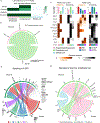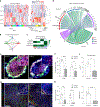Self-organization of sinusoidal vessels in pluripotent stem cell-derived human liver bud organoids
- PMID: 40562862
- PMCID: PMC12486625
- DOI: 10.1038/s41551-025-01416-6
Self-organization of sinusoidal vessels in pluripotent stem cell-derived human liver bud organoids
Abstract
The induction of tissue-specific vessels in in vitro living tissue systems remains challenging. Here, we directly differentiated human pluripotent stem cells into CD32b+ putative liver sinusoidal progenitors by dictating developmental pathways. By devising an inverted multilayered air-liquid interface culture, hepatic endoderm, septum mesenchyme, arterial and sinusoidal quadruple progenitors self-organize to generate and sustain hepatocyte-like cells neighboured by divergent endothelial subsets composed of CD32blowCD31high, LYVE1+STAB1+CD32bhighCD31lowTHBD-vWF- and LYVE1-THBD+vWF+ cells. WNT2 mediates sinusoidal-to-hepatic intercellular crosstalk potentiating hepatocyte differentiation and branched endothelial network formation. Intravital imaging reveals the iPS-cell-derived putative liver sinusoidal endothelial progenitor develops fully perfused human vessels with functional sinusoid-like features. Organoid-derived hepatocyte- and sinusoid-derived coagulation factors enable correction of in vitro clotting time with Factor V-, VIII-, IX- and XI-deficient plasma, and rescues the severe bleeding phenotype in haemophilia A mice on transplantation. Advanced organoid vascularization technology allows for interrogating key insights governing organ-specific vessel development, paving the way for coagulation disorder therapeutics.
© 2025. The Author(s), under exclusive licence to Springer Nature Limited.
Conflict of interest statement
Competing interests: N.S. and T.T. are the inventors of the patent applications WO2020203713A1 and WO2022230919A1. N.S., E.K. and T.T. are the inventors of the patent application WO2020175594A1. T.T. received research funding from Takeda Pharmaceutical Company, Ltd. Y.N., E.K., T.K. and M.F. are employees of Takeda Pharmaceutical Company, Ltd. The other authors declare no competing interests.
Figures
















Update of
-
Self-Organization of Sinusoidal Vessels in Pluripotent Stem Cell-derived Human Liver Bud Organoids.bioRxiv [Preprint]. 2024 Jul 4:2024.07.02.601804. doi: 10.1101/2024.07.02.601804. bioRxiv. 2024. Update in: Nat Biomed Eng. 2025 Jun 25. doi: 10.1038/s41551-025-01416-6. PMID: 39005378 Free PMC article. Updated. Preprint.
References
Grants and funding
LinkOut - more resources
Full Text Sources
Other Literature Sources
Miscellaneous

